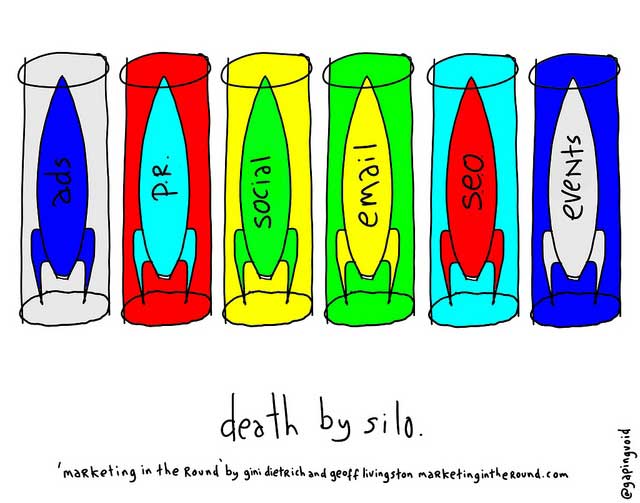Though social media remains the hot topic in the larger marketing conversation, most marketers still rely on a diverse set of tools to develop their multichannel marketing campaigns and inform strategy.
In today's media environment, weaving diverse new and traditional tactics together in an integrated campaign makes the most sense.
The modern marketing organization uses old and new tactics together, including social media, to attract customers, expand markets, and inform future product development and strategy.
Tactical Approaches
Marketing tactics fall into four primary approaches:
- Direct community interaction with stakeholders. Whenever possible, marketers and communicators should directly interact with their primary stakeholders. Tactics include email, direct mail, social media, mobile media, and events.
- Top-down-influence approaches. The top-down approach entails using media—events, public relations, some types of advertising campaigns, and well-known influencers—to inform the marketplace about new products. The message comes to the marketplace from a position of authority to persuade customers.
- The groundswell. The groundswell method of marketing a product or service involves fostering word-of-mouth marketing to loyal customers, who in turn spread the word about you to others, who themselves then go on to disseminate that word-of-mouth. Social media, content marketing, and customer service/loyalty programs are primary tools for this method.
- Flanking techniques. Sometimes companies confront regulations and other obstructions they must get around, or they lack loyal customers, or they don't elicit positive conversation. That's when flanking techniques, such as advertising, content marketing, or search engine optimization (SEO) are deployed as primary tools.
All those approaches can be blended, and some tools can be used across the various approaches. For example, social media can be a lead tool for groundswell approaches, but it can provide customer support for a direct marketing campaign or blogger relations for a top-down approach. You can also use social media to inform your larger product marketing strategy.

How Social Can Fuel Product Strategy
If a product or service falls short of your marketing promise, it creates a gap between the company and the customer. That gap breeds bad word-of-mouth, slows sales, and sometimes results in the complete collapse of the marketing initiative.
In other instances, a competitor may excel, leapfrogging your company with a better offering. How do you know that is happening, and what can your marketing department do about it?
Usually, the first place that disconnects and disruptions expose themselves is online, via social media, thus presenting an opportunity for product marketing and development.
Social media can be so much more than a promotion mechanism; it can serve as a feedback channel for the executive team's strategy sessions and larger programs. That's why in Marketing in the Round, we suggest that marketers integrate social into research functionality and larger marketing and business-decision meetings.
Using social media to inform product marketing is a form of market research. To glean social product-marketing information, your monitoring and analysis tools need to recalibrate toward research goals. You can incorporate three forms of social listening into your current online monitoring dashboard to inform product marketing:
1. Competitive. An examination of market leaders' positioning, offerings, and marketing approaches (e.g., by product category)
2. Stakeholder. Understanding the wants and needs of a customer group, its media-use patterns, and its reaction to previous offerings
3. Inward-focused. An examination of stakeholder interactions on a company's website and social media accounts and a brutal assessment of its strengths and weaknesses
Build extensions of your monitoring solutions to address those areas. The following topics are of interest to many companies:
- Competitor news
- Competitor offerings
- Competitor customer responses
- Stakeholder discussions on category
- Stakeholder discussions on brands (good and bad)
- Stakeholder desires for improvements
- Stakeholder evolution toward new media
- Companies' offerings (positive and negative)
- Desires for new services from the product
Consider divvying up the data into product areas and presenting it in the form of Strengths, Weaknesses, Opportunities, and Threats (SWOT) analysis as the starting point for a meaningful conversation about the evolution and development of your products and services. That conversation should include your executive management team, development organization, and Marketing.
At this point, analysis becomes critical. Which brands are winning customers' hearts and minds? Why have they succeeded? What are the opportunities for the company to modify its offerings and stand out?
Analyze your competitors' offerings online, too. See which efforts spark conversations and understand why stakeholders like them. What is their primary messaging? Why do their efforts work? Which products or services compete directly with your own? What are the price points? Do competitors have public partnerships that help distribute their offerings? How loyal are their customers?
Truly listening to online reactions about an offering, to the competition, and to perceptions of a brand can be tough. Companies, and their marketing teams, are made up of people, and people can be easily upset by one negative comment out of 100. Your marketing team has to steel itself for that moment.






